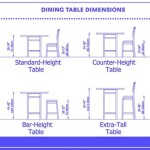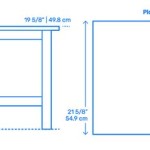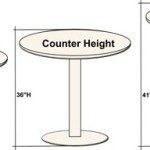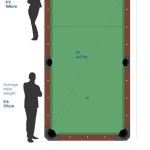What Is A Good Billiards Table?
Determining what constitutes a "good" billiards table involves a multifaceted consideration of materials, construction, and intended use. A table that provides a consistently true and enjoyable playing experience is considered a good investment. Several key factors contribute to this determination, ranging from the slate bed to the frame and cloth.
The quality of a billiards table directly impacts the gameplay, and a poorly constructed table can lead to frustrating inconsistencies in ball behavior. Therefore, understanding the essential components of a billiards table and their respective quality benchmarks is crucial for making an informed purchasing decision.
Slate Bed Quality and Thickness
The slate bed is arguably the most critical component of a good billiards table. The slate provides a flat, rigid surface essential for accurate ball roll. The quality and thickness of the slate significantly influence the table's overall performance and longevity.
Ideally, a good billiards table should have a slate bed made from three individual pieces. This multi-piece construction allows for more precise leveling during installation compared to a single-piece slate. This is especially important for larger tables, where even minor inconsistencies can significantly affect ball trajectory.
The thickness of the slate bed is another critical factor. Professional-grade billiards tables typically feature slate that is at least 1 inch thick. This thickness provides sufficient rigidity to resist warping and ensure a consistently flat playing surface. Thicker slate, such as 1.25 inches, is even more desirable for its increased stability and resistance to movement over time, though it increases the overall weight of the table.
The slate should also be diamond-honed to a precise flatness. This process involves grinding the slate to a specific tolerance, ensuring that there are minimal variations in the surface. Diamond-honing provides a smooth and even surface, which is essential for accurate ball roll and predictable gameplay. The precision of the honing process is a key indicator of slate quality.
Furthermore, the slate should be properly supported by the table's frame. Inadequate support can lead to sagging or warping of the slate over time, negating even the highest-quality slate's benefits. The frame should be robust and designed to distribute the weight of the slate evenly across its surface.
When evaluating a billiards table, it is advisable to inquire about the origin and quality of the slate. Slate sourced from reputable quarries and manufactured to exacting standards is more likely to provide long-term performance. Checking for certifications or adherence to industry standards can further validate the slate's quality.
Frame Construction and Materials
The frame of a billiards table provides structural support for the slate bed and other components. A well-constructed frame is essential for maintaining the table's stability, leveling, and overall durability. The materials and construction techniques used in the frame significantly impact the table's long-term performance.
Hardwoods, such as maple, oak, or poplar, are generally preferred for the frame due to their strength and resistance to warping. These woods provide a solid foundation for the slate and can withstand the stresses associated with regular use. Engineered wood products, such as plywood or MDF (medium-density fiberboard), may be used in some areas, but they should be of high density and properly sealed to prevent moisture damage.
The frame should be constructed using sturdy joinery techniques, such as mortise and tenon joints or dovetail joints. These methods provide strong and durable connections between the frame components, ensuring that the table remains stable and square over time. Screws and bolts should be used in conjunction with these joinery methods to further reinforce the frame.
The frame should also incorporate crossbeams and stretchers to provide additional support and rigidity. These components help distribute the weight of the slate evenly across the frame and prevent sagging or warping. The spacing and arrangement of these support elements are critical for maintaining the table's structural integrity.
The frame should be properly leveled during installation to ensure a flat and even playing surface. Adjustable levelers should be incorporated into the frame's design to allow for fine-tuning of the table's height and leveling. These levelers should be accessible and easy to adjust, even after the table has been installed.
The finish on the frame should be durable and resistant to scratches and moisture. A multi-layer finish, such as polyurethane or lacquer, is generally preferred for its protective properties. The finish should be applied evenly and smoothly to enhance the table's aesthetic appeal and protect the underlying wood.
Careful attention to detail in the frame's construction is a hallmark of a high-quality billiards table. Inspecting the frame for sturdy joinery, adequate support elements, and a durable finish can provide valuable insights into the table's overall quality and longevity.
Cloth Quality and Composition
The cloth covering the slate bed significantly impacts the ball's speed, spin, and overall playing characteristics. A high-quality cloth provides a smooth, consistent surface that enhances the playing experience. The composition, weave, and weight of the cloth are key factors to consider when evaluating a billiards table.
Wool is the traditional material used for billiards cloth. Wool cloth provides a smooth, consistent surface that allows for accurate ball roll and predictable spin. The percentage of wool in the cloth determines its overall quality and performance. Higher wool content generally indicates a superior cloth.
Some billiards cloths incorporate nylon fibers to improve durability and reduce stretching. These cloths are typically more resistant to wear and tear and may be a good option for tables that will be used frequently. However, the addition of nylon can sometimes affect the cloth's playing characteristics, so it's essential to consider the trade-offs between durability and performance.
The weave of the cloth also affects its playing characteristics. A tightly woven cloth provides a smoother, faster surface, while a looser weave can create more friction and slow down the ball's speed. The weave should be consistent and even throughout the cloth to ensure a uniform playing surface.
The weight of the cloth is another critical factor. Heavier cloths are generally more durable and resistant to stretching. A heavier cloth also provides a smoother, more consistent playing surface. The weight of billiards cloth is typically measured in ounces per yard, with heavier cloths generally being preferred for professional-grade tables.
The cloth should be properly installed and stretched to ensure a smooth, wrinkle-free surface. Loose or uneven cloth can significantly affect the ball's trajectory and make it difficult to play accurately. The cloth should be installed by a qualified professional to ensure proper tension and alignment.
Maintaining the cloth is essential for preserving its quality and performance. Regular brushing can remove dust and debris, preventing the cloth from becoming soiled and affecting the ball's roll. Spills should be cleaned up immediately to prevent staining and damage to the fibers.
The color of the cloth is largely a matter of personal preference. Green is the traditional color for billiards cloth, but other colors, such as blue, red, or gray, are also available. The color of the cloth can affect the visibility of the balls and the overall ambiance of the playing area.
When evaluating a billiards table, it is advisable to inquire about the brand and quality of the cloth. Reputable cloth manufacturers use high-quality materials and construction techniques to ensure optimal performance and durability. Inspecting the cloth for a smooth, consistent weave and a durable finish can provide valuable insights into its overall quality.

What Makes A Good Quality Pool Table Solids N Stripes

Good Pool Tables Learn How To Recognize A Well Made Billiards Table Sawyer Twain

What Is The Best Pool Table Available On Market In

Best Pool Tables 2024 Home Billiard To Buy

What Size Pool Table Is The Best Quora

What S The Difference Between Mdf Slate Bed Pool Tables

How Much Does A Pool Table Cost

What S The Difference Between Mdf Slate Bed Pool Tables

Billiards Table The Good Mod

Billiards Table The Good Mod








